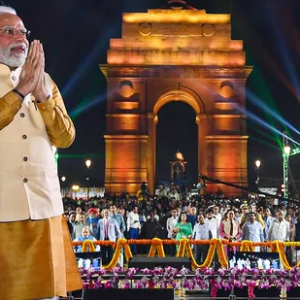Introduction
Unconventional threats of all types and hues, often looks for gaps in the system. A disgruntled person, a vulnerable communication protocol between key positions of power, unrest amongst the population, leaders with allegiance to contrary ideologies, people with compromised credentials and suspect integrity, are all targets for penetration.
While India is the most vibrant of all the democracies in the world, it is also the most chaotic. Indian scriptures talk of balancing chaos and order, while Western mythologies depict the two locked in a zero-sum battle in which order must triumph. That is a reality which holds good for the present day and times. Even in chaos there is an order where everyone is included. The pandemic which engulfed the world and in with which India is now engaged in combatting the second wave, is but one form of an unconventional threat. Here, the severity of the onslaught of the second wave stretched India’s health infrastructure to almost breaking point, leaving the people vulnerable and forced for the most part to fend for themselves. The chaos was therefore without any order.
India’s adversaries consider existence of chaos as a weakness and make persistent efforts to penetrate and dismantle our system. The last two millennium have however proved that our civilisation is robust enough to withstand any onslaught despite losing military and political control. Today, India is a militarily strong power when it comes to conventional means and is an enigma in the unconventional domain for its adversaries. India’s enemies have therefore resorted to emerging technologies to innovate and perforate that invincible shield of our nation.
The Challenge
The last two years have seen an onslaught of events which, when connected together, indicate attempts being made to destabilise India economically, militarily, diplomatically and politically. It would be unwise to see these events in isolation, instead of as a coordinated multi-frontal attack. If viewed in isolation, the response matrix to each of the challenges would be significantly different to the response options that could be exercised when viewed through a holistic perspective. As an example, response to cross border terrorism emanating from Pakistan, led to more robust ripostes in the form of surgical strikes by the Army and an air strike by the Indian Air Force on the Jaish-e-Mohammed camp in Balakot, which has had a salutary impact on the security situation in the country.
To effectively deal with an unconventional threat, we need to examine the the following, to enable us to deal effectively with the threat:
- Assess the nature, scale and reach of the threat.
- Identify the organisation and the group of countries associated with the threat.
- Determine the ability of the enemy to execute the attack and its capacity to sustain the same.
- Real time damage assessment and prediction of future enemy manoeuvres.
- Ability to quantify and deploy resources to contain and diffuse the attack.
The Covid-19 Pandemic
The extent of death, devastation and financial damage the country has suffered due to this pandemic, together with the whole world is manifold as compared to the series of terrorist strikes seen in a whole decade. A clear awareness as to how the pandemic originated, therefore, would have mandated a different strategy and course of action.
The Covid-19 pandemic has confirmed to us the possibility of a hostile power carrying out bio-warfare, with the outbreak being considered by the target population as a natural occurrence and not a planned attack. Such lack of awareness on the part of the targeted population lets the perpetrators scot-free, and emboldens them to plan for and execute further attacks. It is therefore of paramount importance that the cause should be made public at the first available opportunity, so that the adversary is deterred.
Since awareness is a key parameter in determining the course of response; the mechanism to gather and confirm the information therefore takes centre-stage. In a connected world, every piece of information is mostly available. With technologies like Bigdata analytics, it is possible in reasonable time frame to foresee the enemy plans shaping up even before the execution of any attack. Eventuality, modelling for any potential disaster situation has to become an essential part of our everyday routine.
Awareness during an unconventional threat is essential through all the stages of its progression. An unconventional attack mostly subverts and stresses the infrastructure it targets. The Covid-19 pandemic has subverted the entire health infrastructure worldwide. A proper digital platform could have acted as a shield and have absorbed the impact before the physical infrastructure got exposed. This could definitely have prevented the collapse of the machinery as a whole at the least.
The Indian Response
A fundamental weakness in dealing with the pandemic in India has been that despite being declared as a war, it is being fought by multiple agencies as small battles in their respective domains and regions. Consequently, resource management has been sub-optimal, leading to critical shortages in some places and sending the population into a wild frenzy. While it is very important to name the fight as a War, it is of greater importance to fight it as a War.
India’s response, as indeed of the whole world too, on the information warfare front was also sub-optimal. In early January 2020, the indications and enormity of the pandemic was evident in the public domain, yet even the developed countries chose to overlook the impending catastrophe. In India, while the political and medical response for the pandemic was remarkably well handled, the country could have better addressed the challenges on the information warfare front and put in place a converged platform to aid and optimise the healthcare infrastructure. The country had time from February 2020 to April 2021 to put such a system in place.
Platforms like Aarogya Setu were not adequately designed to address the right problem matrix. Consequently, in the midst of the second wave the country was caught on the wrong foot on multiple counts. The lack of adequate information to the masses added to the chaos, which in turn led to further accelerating the spread of the pandemic. Not only did the country as a whole let its guard down prematurely, we collectively refused to envision the lull before the storm. The lessons to be learnt are stark, and the realisation is still dawning upon us, as to how the right decisions, choices and strategies could have made us put up a better show.
A Future Response Strategy
Fighting this war by manual planning or conventional methods cannot yield any results whatsoever. Systems in silos add more to the chaos than deliver meaningful results. It is therefore vital that a comprehensive enterprise grade solution which can receive, purify and transform information from multiple solution frameworks be made available as a pre requisite at the earliest. Such a system shall empower the decision makers with a bird’s eye view over the complete area of responsibility (AoR) which can result in swifter and practical problem response matrix. The planning would then be not on speculative or presumptive data but rather on actuals.
An unconventional warfare always creates a higher coefficient of “Fog of War”. The only method for the fog to be decluttered is by generating realtime intelligence on the adversary, coupled with the assessment of damage caused by the attack. The damage shall always indicate the source and origin of the threat while the intelligence machinery shall give vital insights into the reactions of the adversary. In short it is a closed loop with one system feeding into the other and generating new set of possible outcomes.
To effectively deal with a future pandemic or any other unconventional threat, the following aspects mandatorily need to be in place.
- Fight the unconventional threat under one single agency with a unified command and control, who shall be directly accountable to the CCS (Cabinet Committee on Security).
- NDMA should be led by a senior military officer rather than a bureaucrat, considering the lack of experience in matters of strategy, wartime planning and agile execution of the latter. We have to remember that the best people to ward of any threat of such scale and reach is always the armed forces.
- Risk forecasting and Risk mitigation strategies for all known events must be ready at all times for execution during a regime of attack. Every war should be fought with a war plan, with sufficient scope to be flexible as per the demands of time.
- The organisational structure should be powered by a converged digital platform which shall process multi-disciplinary information, so as to create a unified synthetic picture of the exact state of operations in real-time. An indigenous AI enabled Risk Informed Decision Support (RIDS) platform is an ideal solution framework for this requirement.
The country has moved heaven and earth to fight the pandemic. The efforts and intentions while being laudable, could have achieved a great deal more, if synergy had been created at all levels. Adding to the challenge is opportunistic politics, which acts as a friction to the prevalent fog of war. The National Health Authority undertaking the Digital Health Mission needs an immediate overhaul with experts who are conversant with the subject. These small measures can significantly change the course of this war and leave the country better prepared to fight future threats.
Author Brief Bio: Wg Cdr S Sudhakaran (V) is MD & CEO, QuGates Technologies



